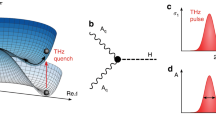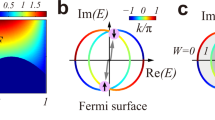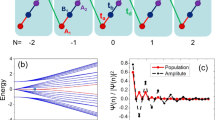Abstract
Spontaneous symmetry breaking plays a key role in our understanding of nature. In relativistic quantum field theory, a broken continuous symmetry leads to the emergence of two types of fundamental excitation: massless Nambu–Goldstone modes and a massive ‘Higgs’ amplitude mode. An excitation of Higgs type is of crucial importance in the standard model of elementary particle physics1, and also appears as a fundamental collective mode in quantum many-body systems2. Whether such a mode exists in low-dimensional systems as a resonance-like feature, or whether it becomes overdamped through coupling to Nambu–Goldstone modes, has been a subject of debate2,3,4,5,6,7,8,9. Here we experimentally find and study a Higgs mode in a two-dimensional neutral superfluid close to a quantum phase transition to a Mott insulating phase. We unambiguously identify the mode by observing the expected reduction in frequency of the onset of spectral response when approaching the transition point. In this regime, our system is described by an effective relativistic field theory with a two-component quantum field2,7, which constitutes a minimal model for spontaneous breaking of a continuous symmetry. Additionally, all microscopic parameters of our system are known from first principles and the resolution of our measurement allows us to detect excited states of the many-body system at the level of individual quasiparticles. This allows for an in-depth study of Higgs excitations that also addresses the consequences of the reduced dimensionality and confinement of the system. Our work constitutes a step towards exploring emergent relativistic models with ultracold atomic gases.
This is a preview of subscription content, access via your institution
Access options
Subscribe to this journal
Receive 51 print issues and online access
$199.00 per year
only $3.90 per issue
Buy this article
- Purchase on Springer Link
- Instant access to full article PDF
Prices may be subject to local taxes which are calculated during checkout





Similar content being viewed by others
References
Weinberg, S. The Quantum Theory of Fields Vol. 2 (Cambridge Univ. Press, 1996)
Sachdev, S. Quantum Phase Transitions 2nd edn (Cambridge Univ. Press, 2011)
Chubukov, A. V., Sachdev, S. & Ye, J. Theory of two-dimensional quantum Heisenberg antiferromagnets with a nearly critical ground state. Phys. Rev. B 49, 11919–11961 (1994)
Sachdev, S. Universal relaxational dynamics near two-dimensional quantum critical points. Phys. Rev. B 59, 14054–14073 (1999)
Zwerger, W. Anomalous fluctuations in phases with a broken continuous symmetry. Phys. Rev. Lett. 92, 027203 (2004)
Podolsky, D., Auerbach, A. & Arovas, D. P. Visibility of the amplitude (Higgs) mode in condensed matter. Phys. Rev. B 84, 174522 (2011)
Altman, E. & Auerbach, A. Oscillating superfluidity of bosons in optical lattices. Phys. Rev. Lett. 89, 250404 (2002)
Pollet, L. & Prokof′ev, N. The Higgs mode in a two-dimensional superfluid. Preprint at http://arxiv.org/abs/1204.5190 (2012)
Podolsky, D. & Sachdev, S. Spectral functions of the Higgs mode near two-dimensional quantum critical points. Preprint at http://arxiv.org/abs/1205.2700 (2012)
Sooryakumar, R. & Klein, M. Raman scattering by superconducting-gap excitations and their coupling to charge-density waves. Phys. Rev. Lett. 45, 660–662 (1980)
Littlewood, P. & Varma, C. Gauge-invariant theory of the dynamical interaction of charge density waves and superconductivity. Phys. Rev. Lett. 47, 811–814 (1981)
Rüegg, C. et al. Quantum magnets under pressure: controlling elementary excitations in TlCuCl3. Phys. Rev. Lett. 100, 205701 (2008)
Bloch, I., Dalibard, J. & Zwerger, W. Many-body physics with ultracold gases. Rev. Mod. Phys. 80, 885–964 (2008)
Spielman, I. B., Phillips, W. D. & Porto, J. V. Mott-insulator transition in a two-dimensional atomic Bose gas. Phys. Rev. Lett. 98, 080404 (2007)
Sengupta, K. & Dupuis, N. Mott-insulator-to-superfluid transition in the Bose-Hubbard model: a strong-coupling approach. Phys. Rev. A 71, 033629 (2005)
Huber, S. D., Altman, E., Buchler, H. P. & Blatter, G. Dynamical properties of ultracold bosons in an optical lattice. Phys. Rev. B 75, 085106 (2007)
Huber, S., Theiler, B., Altman, E. & Blatter, G. Amplitude mode in the quantum phase model. Phys. Rev. Lett. 100, 050404 (2008)
Menotti, C. & Trivedi, N. Spectral weight redistribution in strongly correlated bosons in optical lattices. Phys. Rev. B 77, 235120 (2008)
Graß, T. D., Santos, F. E. A. & Pelster, A. Real-time Ginzburg-Landau theory for bosons in optical lattices. Laser Phys. 21, 1459–1463 (2011)
Stöferle, T., Moritz, H., Schori, C., Köhl, M. & Esslinger, T. Transition from a strongly interacting 1D superfluid to a Mott insulator. Phys. Rev. Lett. 92, 130403 (2004)
Schori, C., Stöferle, T., Moritz, H., Köhl, M. & Esslinger, T. Excitations of a superfluid in a three-dimensional optical lattice. Phys. Rev. Lett. 93, 240402 (2004)
Bissbort, U. et al. Detecting the amplitude mode of strongly interacting lattice bosons by Bragg scattering. Phys. Rev. Lett. 106, 205303 (2011)
Endres, M. et al. Observation of correlated particle-hole pairs and string order in low-dimensional Mott insulators. Science 334, 200–203 (2011)
Sherson, J. F. et al. Single-atom-resolved fluorescence imaging of an atomic Mott insulator. Nature 467, 68–72 (2010)
Gerbier, F. Boson Mott insulators at finite temperatures. Phys. Rev. Lett. 99, 120405 (2007)
Capogrosso-Sansone, B., Söyler, S., Prokof′ev, N. & Svistunov, B. Monte Carlo study of the two-dimensional Bose-Hubbard model. Phys. Rev. A 77, 015602 (2008)
Varma, C. Higgs Boson in superconductors. J. Low Temp. Phys. 126, 901–909 (2002)
Cazalilla, M. A., Ho, A. F. & Giamarchi, T. Interacting Bose gases in quasi-one-dimensional optical lattices. N. J. Phys. 8, 158 (2006)
Bakr, W. S. et al. Probing the superfluid-to-Mott insulator transition at the single-atom level. Science 329, 547–550 (2010)
Randall, L. & Sundrum, R. An alternative to compactification. Phys. Rev. Lett. 83, 4690–4693 (1999)
Acknowledgements
We thank C. Weitenberg and J. F. Sherson for their contribution to the design and construction of the apparatus. We thank D. Podolsky, W. Zwerger, S. Sachdev, R. Sensarma, W. Hofstetter, U. Bissbort, L. Pollet and N. Prokof′ev for discussions. We acknowledge funding by the MPG, DFG, EU (NAMEQUAM, AQUTE, Marie Curie Fellowship to M.C.), JSPS (Postdoctoral Fellowship for Research Abroad to T.F.) and California Institute of Technology (IQIM and Lee A. DuBridge fellowship to D.P.). The computations in this paper were done on the Odyssey cluster supported by the FAS Science Division Research Computing Group at Harvard University.
Author information
Authors and Affiliations
Contributions
All authors contributed extensively to the work presented in this paper.
Corresponding author
Ethics declarations
Competing interests
The authors declare no competing financial interests.
Supplementary information
Supplementary Information
This file contains Supplementary Text and Data 1-4 and Supplementary Figures 1-8. (PDF 1478 kb)
Rights and permissions
About this article
Cite this article
Endres, M., Fukuhara, T., Pekker, D. et al. The ‘Higgs’ amplitude mode at the two-dimensional superfluid/Mott insulator transition. Nature 487, 454–458 (2012). https://doi.org/10.1038/nature11255
Received:
Accepted:
Published:
Issue Date:
DOI: https://doi.org/10.1038/nature11255
This article is cited by
-
Dual Higgs modes entangled into a soliton lattice in CuTe
Nature Communications (2024)
-
A Comprehensive Review on Synthesis, Phase Transition, and Applications of VO2
Journal of Superconductivity and Novel Magnetism (2024)
-
Generation and decay of Higgs mode in a strongly interacting Fermi gas
Scientific Reports (2023)
-
Quantum simulations with ultracold atoms in optical lattices: past, present and future
Journal of the Korean Physical Society (2023)
-
Collective dynamics and the Anderson-Higgs mechanism in a bona fide holographic superconductor
Journal of High Energy Physics (2023)
Comments
By submitting a comment you agree to abide by our Terms and Community Guidelines. If you find something abusive or that does not comply with our terms or guidelines please flag it as inappropriate.



